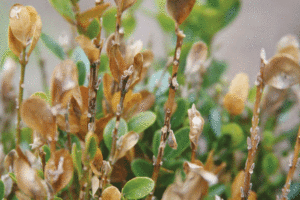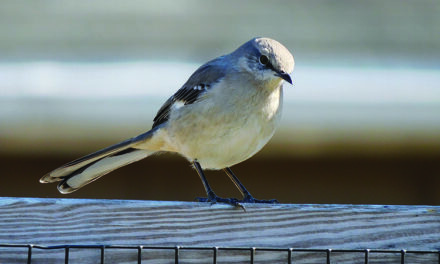
Heavily infected plants drop most of their leaves. Although the plant attempts to regrow, repeated infection and defoliation can weaken the root system and lead to plant death, especially for young plants or new transplants. (Photo courtesy Georgia Department of Agriculture)
The Maryland Department of Agriculture urged residents to use caution when buying fresh holiday decorations and greens containing boxwood this past season, noting that using boxwood greens could potentially introduce a serious fungal disease called boxwood blight to surrounding boxwoods.
Heading into the spring and summer months, the disease can easily move by attaching to gloves, clothes and tools so even though holiday decorations are down, it’s still something to watch out for.
Boxwood blight is caused by a fungus called Cylindrocladium pseudonaviculatum.
Symptoms begin as leaf spots followed by rapid browning and leaf drop starting on the lower branches and moving upward in the canopy.
The key symptoms that make Boxwood Blight different from other boxwood diseases are numerous thin black streaks that develop on the green stems.
Boxwood blight infects all above ground portions but does not appear to infect the roots.
Fungus can remain alive in fallen leaves, which may serve as the source of infection for subsequent years as infected plants are exposed to moisture and temperature, severe blight and decline can occur.
This fungus also produces sticky spores, which can be easily transported by human activities.
The major means of transmission for boxwood blight is through moving plants and contact with contaminated clothing, tools or equipment according to the MDA.
Sanitation is essential.
Keep all tools clean and change clothing when working in the area.
English boxwood, Korean boxwood, American boxwood, little leaf boxwood, Japanese boxwood and hybrids are all susceptible to this fungus.
Symptoms appear as dark or light brown spots or lesions on the leaves.
These lesions often have dark borders.
Heavily infected plants drop most of their leaves.
Although the plant attempts to regrow, repeated infection and defoliation can weaken the root system and lead to plant death, especially for young plants or new transplants.
Boxwood blight can spread very rapidly under warm and humid conditions.
In 2011 many established boxwood plantings were apparently killed in one season following the introduction of infected plants.
Noteworthy is that 2011 was a particularly cool, wet year that included several violent rain events.
It has a rapid disease cycle that can be completed in one week. It has a temperature range of 41-86 degrees.
The optimum temperature for growth is 77 degrees.
The fungus is sensitive to high temperatures and is killed after seven days at 91 degrees. Infections can occur very quickly under warm (64-77 degrees), humid conditions.
The boxwood blight fungus forms fruiting structures quickly on infected plants.
These structures called sporodochia, can be seen on the undersides of infected leaves and on the black lesions on stems. Sporodochia contain large numbers of sticky spores.
The spores are splash dispersed and can be carried by wind or wind-driven rain over short distances.
Longer distance spread is thought to occur by activities like contaminated boots, clothing, equipment, animals and birds since the spores are sticky.
Infected plant material is the primary means for long-distance spread. Movement is the primary method for the spread of this disease to healthy boxwoods, even those treated with fungicides that suppress, but not kill the fungus.
The blight does not need a wound in the plant to infect it.
The disease can penetrate directly through the plant cuticle or can enter the leaf through stomata. However, high humidity levels or free water on plant tissues are necessary for successful infection.
Raking and removing leaf debris, is critical since the fungus can survive in plant debris for up to five years.
Safely burning the plant debris might be an option to consider. Infected plant material should not be composted.
Inspect boxwood plants daily or weekly.
As soon as boxwood blight symptoms are detected, horticulturalists recommend you pull and remove the whole plants immediately.
Place the plant in a plastic bag to avoid carrying the infected material through an area that can affect other boxwoods.
Fungicide effectiveness in countries that have been dealing with this disease for many years has not been encouraging.
Most fungicides have not been effective. However, used in conjunction with recommended cultural strategies, especially when weather is favorable for disease, has been productive.
When there is a risk of boxwood blight occurring, fungicide applications need to be used on a regular preventive schedule.
Due to the tight nature of the boxwood canopy, thorough coverage with fungicides is difficult.
However, all parts of the plant need to be covered so any sprays should be applied until run-off.
Because this is a new disease for the U.S., boxwood blight will not be on any fungicide labels.
The fungicide labels of products that can be used on boxwood will contain information on dosage rates, reentry intervals, and safety precautions.
Among the fungicides registered for use on boxwood are anoxicrobin, boscalid plus pyraclostrobin, chlorothalonil, fludioxonil, kresoim-methyl and mancozeb.




